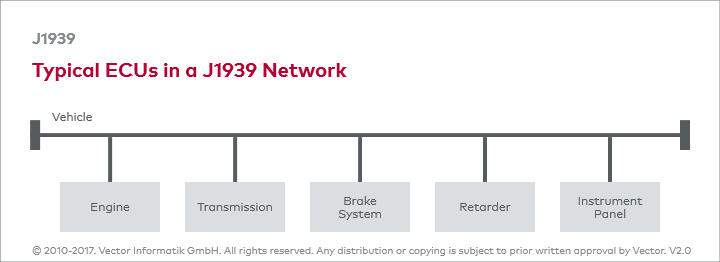- Overview
- 1. Introduction
- 2. General Description of the Protocol
- 3. Document Structure
-
4. Fundamentals
- 4.1. Names and Addresses
- Device Names
- Device Address
- 4.2. Parameter Group
- General
- Structure and Type of a Parameter Group
- Example of a Global Parameter Group
- Example of a Specific Parameter Group
- Parameter Groups reserved specially for the Protocol
- 4.3. Data Management
- Suspect Parameter Number (SPN)
- SLOT Definition
-
5. Network Management
- Network Access
- 5.1. Address Conflict
- Solution and Configurations
- Handling in a Dynamic Network
- 6. Transport Protocols (Multi-packet Messages)
- 7. Diagnostics
Motivation for J1939
SAE J1939 Protocol
The SAE (Society of Automotive Engineers) J1939 protocol is a higher-layer protocol based on CAN (Controller Area Network). It is used in commercial vehicles and construction machinery for communication of electronic control units. The protocol was developed in the mid-1980s to ensure standardized communication between electronic control units of different manufacturers. It focuses on the diesel engine and its communication with, for example, the gearbox, brake, or retarder (engine brake).
SAE J1939 und CAN (Controller Area Network)
The SAE J1939 protocol uses CAN (Controller Area Network, ISO 11998-1 and ISO 11998-2) as the physical layer. The CAN protocol plays a major role in motor vehicle networking and represents a commonly used method for bit serial communication between electronic control units (ECUs). Typical ECUs include: Engine, transmission, and brake ECUs as well as the instrument panel and door ECUs.

